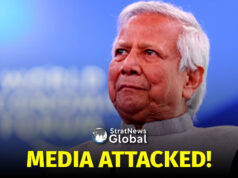The Nepali Congress (NC) and Communist Party of Nepal (UML) have agreed to form a new coalition government under the leadership of former Prime Minister KP Sharma Oli.
It means an end to the one and half year-long rule of Prime Minister Pushpa Kamal Dahal ‘Prachanda’, who headed the government three times within the period, backed either by the NC or the CPN (UML).
Leaders from both parties confirmed that a power sharing agreement had been reached on Monday night.
“An understanding has been reached between UML and the NC to form a national consensus government under the leadership of KP Sharma Oli,” CPN-UML General Secretary Shankar Pokharel posted on Facebook on Tuesday.
NC’s Central Working Committee member and former Finance Minister Prakash Sharan Mahat, also confirmed to Stratnewsglobal that the two parties reached an understanding to form a new government led by Oli.
“As per a written agreement signed between the two parties on Monday, Oli and former Prime Minister and Nepali Congress President Sher Bahadur Deuba, will lead the government turn by turn for the remaining period of the current House of Representatives, the lower house.”
Nepal’s last parliamentary elections were held in November 2022, so there are still three and half years left for the expiry of the current lower house.
“There has been an understanding that Oli will lead the government for the first half of the remaining period and Deuba will lead for the rest of the period until next parliamentary elections are held,” Mahat said.
It’s unusual for two of the largest parties to come together, more so when they represent ideologically opposite poles. But Nepal has a history of major parties coming together to form either a national consensus government or a majority government. The last time, the NC and UML came together was in 2013 after elections to the second constituent assembly.
“If Prime Minister Prachanda resigns from his post immediately, the new government will be formed very soon,” said Mahat. “Otherwise, it may take some time.”
The political buzz is that ever since Prachanda ditched the NC to form a new coalition with the UML in March this year, the NC was looking to hit back. NC leaders had even proposed Rabi Lamichhane, leader of the Rastriya Swatantra Party (RSP), for prime minister. It is the fourth largest party in Nepal’s parliament.
The two parties also agreed to amend the constitution promulgated in 2015.
“The two sides realized that there should be a constitutional amendment to ensure political stability,” said Mahat. “They agreed to amend the electoral system so that the cycle of political instability that has affected development, good governance and the economic prosperity, could be ended.”
Nepal has adopted a mixed electoral system to elect the 275-lawmakers for the House of Representatives. Of the total, 60 percent (165 lawmakers) are elected through the first-past-the-post system while 40 percent (110) are elected under the proportional representation system.
As a significant portion of the lawmakers are elected through the proportional representation system, it is difficult for any political party to secure a majority seats in the lower house. Currently, the NC has 88 lawmakers followed by UML with 79. The CPN (Maoist Centre) led by Prachanda has 32 seats in the lower house.
Ending the current form of proportional representation system can be a matter of discussion to ensure political stability,” said Mahat. “But we are also mindful to ensure inclusion.”




